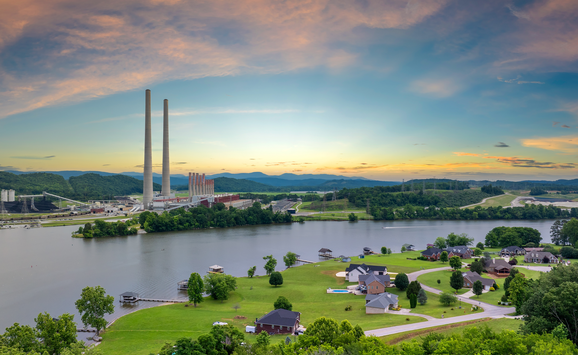Ever since the potentiality of nuclear fission for generating electric energy was first recognized, periods of enthusiasm, sometimes accompanied by rapid forward strides, have alternated with periods of pessimism and slowdown. The past year was no exception as, for a variety of reasons, yet another round of reevaluation took place. To be sure, the uncertainty of the early years stands in sharp contrast to the situation today: 15 nuclear plants, with an electric generating capacity of 3,900 megawatts are in full operation or nearly so; another 89 plants capable of generating nearly 75,000 mw are either under construction or have been announced in advance commitments by the nation's utilities. Such investments or plans appear to leave little doubt about the viability of commercial nuclear power.
Yet recent events connected with U.S. nuclear power plants spell uncertainty on a number of fronts. A central issue is costs. Up to 1963, When there were seven operating atomic plants in the United States (with combined generating capacity of 660 mw), civilian nuclear power had benefited from substantial governmental financial assistance, mainly in research and development and in the construction of reactors on utility grids. A milestone was assumed to have been reached in 1963 with the disclosure that the first totally privately financed atomic plant, the Oyster Creek plant of the Jersey Central Power Company, was expected to have lifetime generating costs of under 4 mills per kilowatt-hour. This cost, if achieved, clearly would spell the arrival of nuclear energy's competitive status. The TVA's commitment to nuclear power in 1966 (with a plant cost below that of Oyster Creek), and again in 1967, tended to reinforce the impression that nuclear's competitive era had indeed dawned.
From the start the Oyster Creek Cost estimate has been viewed with some doubt—given the suspected (and later acknowledged) price shading by equipment manufacturers anxious to open up a new market. Also, despite the nominally private financing of the entire undertaking, there were possible elements of government subsidization which could take a variety of forms (e.g., leasing of government-owned nuclear fuel, pricing of nuclear enriching services) and which were quite separate from the direct earlier governmental assistance mentioned above. A delay in completion of more than two years has not only added to doubts but has also raised costs: to the utility, by exacting service charges on nonproducing investment over a longer period, and to the supplying contractor, through unforeseen construction difficulties (e.g., cracks in the welding on the nuclear pressure vessel).
Operating experience for Oyster Creek still lies ahead since the plant was only placed on commercial service late in December. It is also worth noting that Jersey Central announced in August that it was delaying addition of a second nuclear unit until 1976 in favor of constructing a 400-mw oil-fired plant.
The extreme delays encountered at Oyster Creek may not be surprising considering that it is one of the first nuclear plants of very large size. However, they are by no means the only stretch outs in atomic plant construction schedules.
A comparison made June 30, 1969 between original and revised scheduling for generating units to be installed between mid-1969 and 1973 shows the following: Of all units (300 mw and larger) officially reported to the Federal Power Commission as ordered, 22 of the 53 nuclear units (or 40%) were experiencing delays averaging nine months, while only 14 out of the 113 fossil-fuel units (or 12%) were reported to be delayed, the average delay being five months. Among fossil-fuel units, 20% were ahead in scheduling by a four-month average; while among nuclear units only 10% were ahead with an average of three months.
The costs of the nuclear plant delays are not easily measured. At the 1969 annual convention of the Edison Electric Institute, the chief executive of the Southern California Edison Company estimated that "a cumulative delay of at least 15,000 megawatt-years is now expected for those nuclear units now under construction. . . . if only half of the overall investment for these plants is involved in delays, additional carrying charges alone will amount to between $200 million and $300 million during the next four years."
The type of obstacle encountered varied; but the unanticipated difficulty of embracing a new technology on a massive scale, both in number and size of plants ordered, is well illustrated by the prolonged and almost total breakdown of operations in 1969 of Babcock and Wilcox's plant for manufacturing reactor pressure vessels, which the firm produces under subcontract to the primary equipment suppliers.
Delays aside, the quoted costs of building new generating capacity for a 1,100-mw nuclear unit rose by 20% and generating costs by over 25% between 1967 and early 1969, according to Philip Sporn, retired president of American Electric Power Co. Of course, increased costs have hit all utilities; but on an overall basis costs of nuclear units have risen more rapidly than costs of conventional ones.
As a result of the stretch out and cost increases the nuclear share in new generating commitments has fallen off markedly: from more than 50% in 1967 to under 40% in 1968, and to around 15% during the first nine months of 1969. In terms of annual additions to capacity, the share of nuclear generation, barring further delays, should rise from about 12% in 1969 to 30% in both 1970 and 1971, 38% in 1972, and over 55% in 1973.
The delay in completions has resulted in intensive efforts of utilities to guard their reserve capacity margins by installing more quickly deliverable but comparatively expensive fossil-fuel capacity—a good deal of it gas-turbine generators which first gained popularity as standby and peaking units after the 1965 Northeast blackout. One of the nation's largest utilities, Consolidated Edison of New York, has disclosed plans to add about 1,800 mw of gas turbine capacity by 1971.
Reflecting its expectation that the setback will be temporary, the AEC continues to project a range of nuclear generating capacity in 1980 with a midpoint figure of around 150,000 mw. The assumption may be optimistic according to a recent survey among U.S. utilities conducted by the Atomic Industrial Forum; this comes up with a considerably lower estimate of approximately 113,000 mw.
A factor that is unlikely to have influenced decisions in 1969 but may do so in 1970 and beyond is the projected sale to private industry of the three government-owned nuclear enrichment plants. As a first step, President Nixon recently ordered the AEC to separate the three plants from its other operations so as to facilitate eventual disposal. But disposal raises questions not only of the level at which the price of nuclear fuel is likely to settle (a factor in decisions of utilities to order nuclear units), but of such issues as competition, the chances for emergence of new technology, and the difficulty and cost of control over what is always potential bomb material.
At the same time, the proposal highlights the extent to which the security requirements of nuclear power are no longer deemed to demand government ownership. After some 20 years the nuclear industry could now be at the point where the last vestige of government-owned operations is on its way out.





